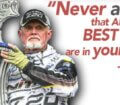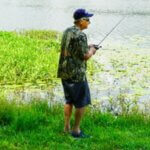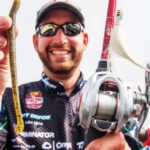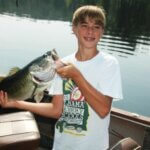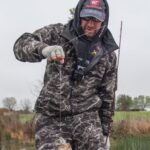Editor’s Note: While deer hunting out of a tree stand, I realized that tree stands were one of the most-productive places on earth to ponder the deep mysteries of life when you’re high above the earth, close to God and free to meditate away from ringing telephones, loud music and people with nothing to do but interrupt your work. There you could think about and try to solve the mystery of how to find the biggest bass in any lake, which is a mystery I’d thought about often. Never before having been able to locate the biggest bass in any lake, I decided that to find that fish, I might be able to use the same strategies a detective would utilize to find a missing person. He would begin by interviewing everyone who knew that person intimately. He would talk to the people who’d had business dealings with him, and he would gather information from the people who’d spent the most time with him. Soon a pattern of his habits and haunts would become evident. Then to locate that missing person, the investigator would look in the areas where the person most likely would be. If through interviewing the ones who knew him best, the detective discovered hideouts that the person had retreated to in the past to dodge danger or elude pursuit, then the investigator reasonably could assume that more than likely he’d use one of these sanctuaries again. I decided the tactic I’d employ to find the biggest bass in any lake would follow these same guidelines and realized that the G.O.A.T.S. (Greatest of All Times) of bass fishing would have the best and most-accurate information. (John E. Phillips’ latest bass book, “Bass Fishing’s G.O.A.T.S. – Greatest of All Times – Know How to Catch Bass,” will be published in summer of 2023).

Bass in Heavy Cover
Next, I talked with Hank Parker of South Carolina, a Bassmaster Classic winner in 1979 and 1989, one of the nation’s best bassers and longtime veteran producer and TV show host. Parker believes that when a bass passes 4 pounds, the fish has eliminated all the predators that have threatened its life except one – the angler. “Therefore, I think a bass larger than 4 pounds realizes that in the presence of man, he becomes the prey. A bass this size hides from and avoids areas where it may encounter the supreme predator, man. I’ve learned that big bass that have been unmolested are far easier to catch than bass that have been pressured by anglers. Search-out sites that receive very little fishing pressure – even if the spot doesn’t look as though it will hold a bass. A bass on a small, solitary piece of heavy cover is more likely to take your lure than a bass of the same size that’s holding on obvious cover that sees 20 or 30 lures a week.
“However, sometimes big bass will hold on obvious cover in high-pressure zones, but these fish are very difficult to catch. Often the only way to get a lunker that’s positioned on obvious cover to bite is to stay well away from the cover and make one accurate, long cast to that cover, instead of four or five casts. Make sure the lure swims perfectly and naturally by the cover and doesn’t intimidate the fish. To catch a big bass in a high-pressured zone, you can’t beat the water to a froth with your lures.”
Bass on Clean Banks
Many top bass anglers take numbers of big bass on clean banks that don’t have any cover or structure on them that should hold a bass. Most fishermen will look at these regions and say, “I’m not going to fish that spot because there’s no reason for a bass to be in that place.” Although there may not be but one or two bass in 1/2-mile of clean bank, those couple of bass usually will be larger bass that are very aggressive, because they haven’t seen many lures.

Bass on Tips of Long, Deep Points
Another place pro bassers discover bigger bass is on the deep tips of long points. Since most anglers fish in the top 5 to 8 feet of water on a long point, that zone is the story of water that receives the most fishing pressure, boat traffic and wave action. All that pressure on the baitfish and bass causes them to move out onto the deep end of the point. Although very few anglers fish the deepest tip of a point before it drops off into a creek or a river channel, that’s where some of the best bass anglers locate the bigger bass.
By interviewing these bass anglers, I’ve learned by fishing longer and more intensively in what appears to be non-productive areas to most anglers, a fisherman may be able to catch bigger bass. Investigators searching for missing persons and hunters looking for trophy deer know that hunting the places and using the tactics that no one else has considered often pay dividends in finding people, deer and bass.
Tomorrow: G.O.A.T.S. Find Bass in Cover
Expert Guidebooks on Bass Fishing: Best Sellers

If you want to become the best you can be, find someone who’s already become the best at what you want to do and follow his or her instructions. This is what I’ve done in my new book, Bass Pros’ Season by Season Tactics.
In this book, I’ve chosen some of the best bass fishermen to give you advice on how to find and catch bass during each period of a bass fish’s life, including professionals like Kevin VanDam, Denny Brauer, David Fritts, Rick Clunn, Larry Nixon, George Cochran, Mark Davis, Woo Daves, Gary Klein, Davy Hite, Michael Iaconelli, Skeet Reese, Mark Rose, and Shaw Grigsby.
My hope is that this book will help you find and catch more bass at every time of the year and each day you’re on the water. The men included in this book are some of the best mentors I know of for successful bass fishing anywhere in the nation.
VERSIONS: AUDIBLE & PRINT
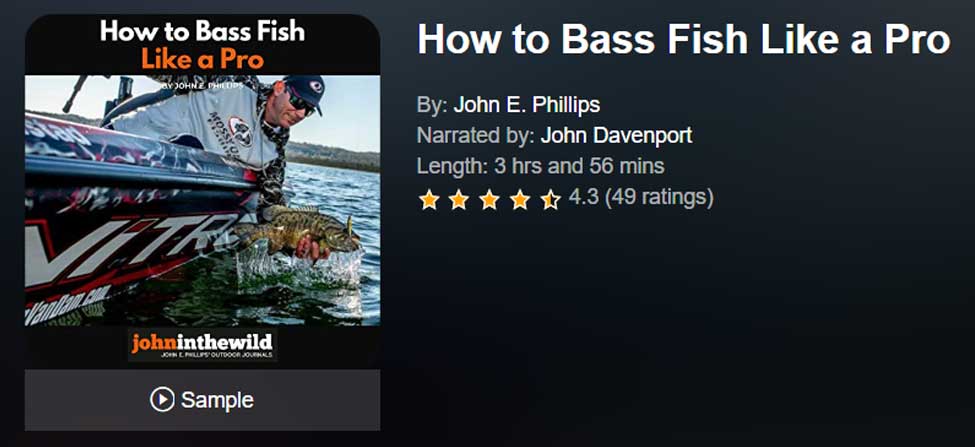
How to Bass Fish Like a Pro
If you could sit down and interview some of the best pro bass fishermen in the world, what would you want them to tell you to help you improve your bass fishing skills?
In this book, How to Bass Fish Like a Pro, Kevin VanDam explains how he catches bass consistently, and how he fishes all 12 months of the year. In the bonus chapters, he will tell you how to fish for hot-weather bass.
Denny Brauer will tell you the ways he hates to fish, how he picks the best fishing lures for different water and weather conditions, and will give you his best fishing tips for hot weather. In Brauer’s bonus chapters, he’ll teach you when to flip a jig, a tube, or a creature bait and tell you his three tips for how to be a better fisherman.
Mark Davis, in Chapter 3 of the book, explains his five secrets to becoming a better bass fisherman, how to turn your bass fishing around to the positive side, and how to catch hot-weather bass. In the bonus chapter, you’ll get six different interviews with Davis, where he tells you: three tips for becoming a better bass fisherman; his three favorite bass lures; and how to keep a big bass on the line and get it to the boat.
James Niggemeyer tells you how to become a bass pro. He also tells you how to catch bass when the weather sizzles. In Niggemeyer’s bonus chapter, he explains how to move from being a bass-club fisherman up to being a pro.
Mark Rose will explain his five favorite go-to bass lures, and how to catch bass in the middle of the summer.
In this book, you’ll hear from top-performing pro fishermen about how they catch big bass consistently, and what they do to win millions of dollars as professional bass fishermen.
VERSIONS: AUDIBLE, KINDLE & PRINT

Catch the Biggest and Most Bass in Any Lake
If you were having open-heart surgery at the hospital, you’d want the best doctor with the most experience and the latest equipment and techniques that money could buy to do your operation. You’d study these doctors’ credentials to learn who was the best.
This is the same type of research that author John E. Phillips has done with the best bass fishermen in the nation to solve the problem of how to find and catch the biggest and the most bass in any body of water that he fishes.
This is the same type of research that author John E. Phillips has done with the best bass fishermen in the nation to solve the problem of how to find and catch the biggest and the most bass in any body of water that he fishes.
In this book, you’ll hear about the techniques, tips, baits, lures, and tackle that 18 of the nation’s best professional fishermen use to support their families by winning bass tournaments and catching the most and the biggest bass they can in every tournament they fish.
Most of these anglers are Bassmaster Classic winners, Megabucks winners, Angler-of-the-Year and FLW Tour winners – like Rick Clunn, Kevin VanDam, George Cochran, Mark Davis, Paul Elias, Skeet Reese, Larry Nixon, Hank Parker, Ken Cook, Denny Brauer, Alton Jones, and Jay Yelas.
Also, every serious bass fisherman should know Timmy Horton, Mark Rose, Randy Dearman, Harold Allen, Mike Wurm, and Shaw Grigsby, men whose tactics you’ll find in this book. To learn how to fish for bass and change your bass-fishing trips from fishing trips to catching trips, this book is a must-have.
VERSIONS: AUDIBLE, KINDLE & PRINT
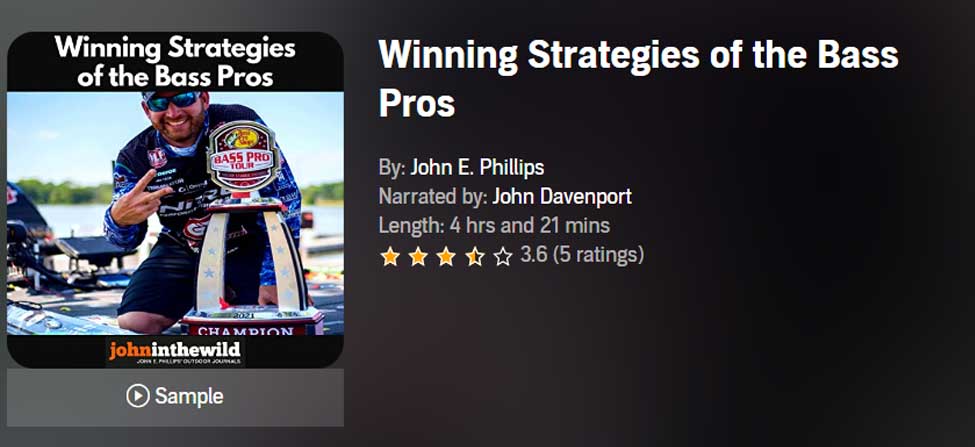
Winning Strategies of the Bass Pros
I learned many years ago if you want to be the best you can be, then you need to learn from the best – particularly when you want to be the best bass fisherman possible. That’s why I’ve written Winning Strategies of the Bass Pros about 11 top bassers.
If you’re wondering at what age you can start learning about bass fishing, you’ll see in the first two chapters about two young men who have come up through the ranks of collegiate bass tournaments – Jordan Lee, who won the Bassmaster Classic in 2017, and Dustin Connell, who won $100,000 in a B.A.S.S. Elite Series tournament in Mississippi in 2017. Top-name pros on both the B.A.S.S. circuit and the FLW circuit are in this book, including Kevin VanDam, Jay Yelas, George Cochran, Rick Clunn, Larry Nixon, Woo Daves, Randy Howell, Scott Canterbury, and Gary Klein.
VERSIONS: AUDIBLE, KINDLE & PRINT
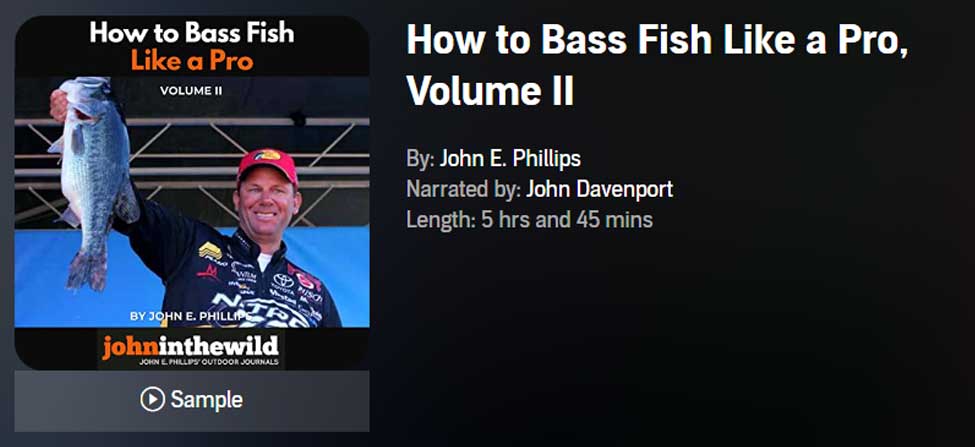
In How to Bass Fish Like a Pro, Volume II, you’ll learn tips and tactics from 21+ Bassmaster Classic winners, two Major League Fishing champions, and 20+ Bassmaster Anglers of the Year about some of the dramatic changes in bass fishing, like:
Depth Finders: You need the latest and greatest depth finders available, since they’re the brains of a bass boat with maps, GPS, side scanning, down scanning, and forward scanning features that enable you to see underwater structures and fish 100-feet away with a 360-degree view. Today’s competitive bass anglers may have four or five depth finders located on the consoles and the bows of their boats.
Other Changes in Equipment: Power fishing for bass using heavy line and rods, big baits, and bait-casting reels that resemble winches have given way to finesse fishing and new techniques like fishing the Ned Rig, the Neko Rig, the Chicken Rig, and the Tokyo Rig on spinning tackle and line as small as 6-10 pounds.
The Growth in Youth and College Competitions for Bass: A young person can begin competition fishing as early as the second grade and continue throughout high school. After that, if the competitor qualifies, he/she may win a scholarship to fish on a college team that eventually may lead them to a professional bass-fishing career.
Changes in the Ways Anglers Bass Fish: Many of the most-consistent winners never pick-up their rods to fish during pre-fishing. Instead, they’ll idle across the water, dropping waypoints from their electronics in places where they’ve identified schools of bass holding. These contestants will have at least 50-250 locations, where they’ve pinpointed schools of bass before a tournament starts.
VERSIONS: AUDIBLE, KINDLE & PRINT

